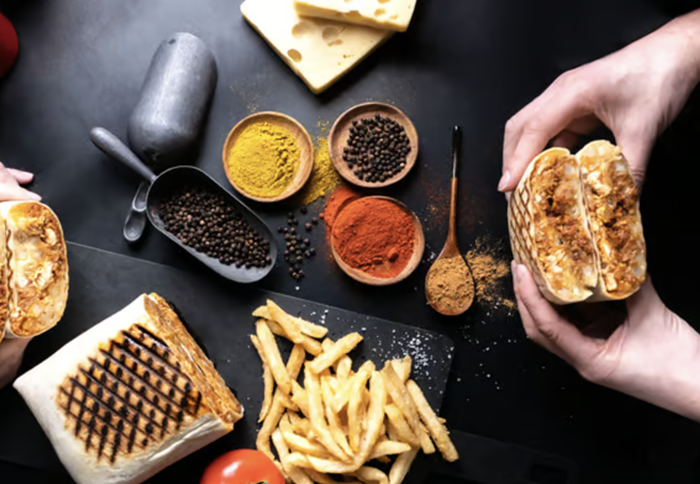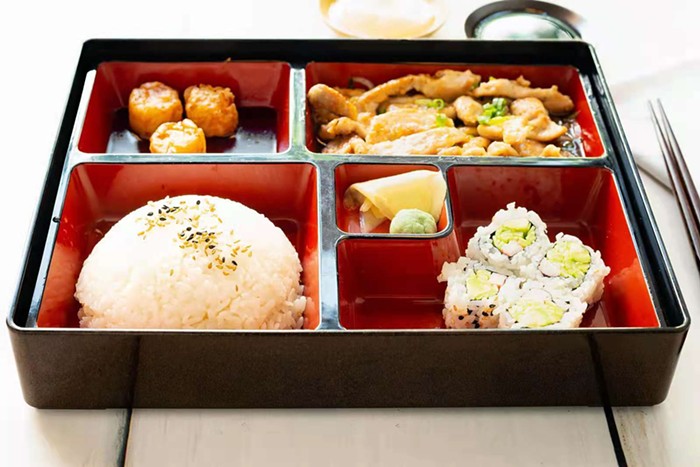Halfway between Ivar's and Gas Works Park is a magical place called Westward. When you see the big sign with the oyster shells piled up around its foot, in the middle of nowhere beneath the Burke-Gilman Trail on Northlake Way, you are here. (Assuming you're not arriving by boat, in which case, use your sextant and to hell with you.) You walk down the driveway, and there's a blazing hot fire surrounded by a ring of more oyster shells, and those surrounded by Adirondack chairs, with cozy blankets draped here and there. The view is of the city across the water to the south, a view you probably rarely see. On a recent sunny late afternoon, it all glinted and dazzled like an urban mirage; on a recent foggy night, ghosts of boats were barely visible, the water more a sound than a sight.
If you want to sit outside—if the weather permits—they'll bring you sparkling wine and oysters on the half shell and whatever else you like. Inside, you'll find a shipshape oyster bar and, adjoining but with its own door, Westward. By the host stand hang portraits of Captain Merrill Stubing (of the Pacific Princess), Captain Steve Zissou (the Belafonte), and two more seamen. The host doesn't know who the others are; one of them looks like the Gorton's fisherman. They're planning to add to their wall of captains, she says.
The dining room has pilings for pillars, with cleats on them to hang up your coat. Big lampshades up above are decked out with numbers and stripes, as if made out of sails. The restrooms, behind a rope divider, have portholes in the doors. Other light fixtures appear to be made of old wire crab-traps. The staff wears nautical, jauntily striped shirts, like Halloween French sailors; one might even wear a woolen watch cap. Mainly, though, there's the huge cutaway diorama of a ship on the wall behind the bar, like the one in The Life Aquatic but, alarmingly, more quirky and more charming. Instead of the rooms from a ship, each one contains its own bizarre miniature world: There's a deep-sea diver plunging through the ceiling of an underwater dining room, the Abominable Snowman going on an icy-blue rampage, dogs calmly playing poker, a gallery with tiny replicas of the Delft ceramic machine guns of local artist Charles Krafft. If you squint at certain miniature rooms you can't really see (is that a model train?), a sailor-shirted server will bring you a small spyglass in a wooden box. The spyglass does not work particularly well, but it certainly is cute as hell.
Aside from Charles Krafft being a white nationalist and Holocaust denier, this all sounds undeniably like a surfeit of whimsy. There are worse things than whimsy (like white nationalist Holocaust deniers), but if you described this restaurant to me, I would mentally run screaming in the other direction.
But somehow Westward is unannoying, not too cute, and thoroughly enjoyable. It's loud in that way that sounds like everyone's having fun but not shouting about it, and so that you don't have to hear quite the whole conversation of the people right next to you. It's big and busy enough that your eye doesn't get caught on, say, three maritime thingamajigs at once. The servers are genuinely nice and seem genuinely happy to be here. And the no-man's-land location makes it feel like you've stumbled into a fun, slightly weird alternate reality, not that you've ended up in some Wes Anderson fanatic's creepy fantasy.
Josh Henderson, of Skillet fame, made Westward. (A server said that he's obsessed with The Life Aquatic; he denies obsession but says he does love the movie.) The chef is Zoi Antonitsas, formerly of the excellent Madison Park Conservatory. The food is very good, when it's not outright great.
The oysters on the half-shell were spectacular—especially the Sea Cows from Hama Hama, much smaller than you'd expect an oyster called a cow to be—and your shucker might bring them to the table and tell you exactly what local inlet they're from and how close he came to winning a shucking championship recently. Little paper flags with the oysters' names on them are stuck in the bed of ice (highly helpful). The mignonette is made with Banyuls five-year and champagne vinegar, plus pink peppercorns.
The menu proper is odd: only two seafood entrees, the rest smaller plates. (I ignored the meats and roasted chicken, as seemed only appropriate.) But who wouldn't rather try a couple of fish-things rather than just one? The smoked Manila clam dip ($11) was like a bespoke, oceanic version of the onion-soup-mix one, in the best possible way. If the house-made potato chips that come with it had been hot upon arrival, it would've been terrifyingly good. The quick-fried squid ($12) was what every sad serving of fried calamari ever wanted to be: the breading so thin and crisp, you could still taste the actual flavor of the squid, which was not even faintly rubbery, just bouncy and almost sweet. Underneath was a potato skorthalia—Antonitsas is Greek—which was like the lightest, most lemony mashed potatoes ever; fish-'n'-skorthalia should be a thing. An octopus Bolognese risotto ($19) was rich and tomatoey, with squid-ink aioli for yet more richness and sea-flavor, but it had only small pieces of octopus, which was mildly disappointing. Grilled sardines ($13) came with the world's lightest versions of tahini and melitzanosalata, a lemony Greek blackened eggplant puree: outstanding.
One of the bigger plates, a Moroccan fish stew ($26), was excellent in its components—exceptionally juicy mussels, creamy potatoes, big pieces of grilled bread, a mildly spicy sauce of ras el hanout and cream, and a gorgeous piece of halibut laid over the top—though none of it seemed especially fated to be in the same bowl together. But a special of four scallops nestled in a dish of shallot crème-fraîche sauce with chanterelles ($16) was meant-to-be, tasting like the forested coast in autumn.
Forays outside the seafood realm included fried brussels sprouts ($11), which, due to being cut into small pieces, absorbed too much oil. Firm slices of grilled halloumi cheese ($13) served with persimmons, walnuts, and honey—in the sole misstep, this dish was forgotten by a server—proved to make an excellent dessert. Also perfect for dessert: a house-made spiced rum, which tasted like sitting fireside with good socks on instead of like eating a Christmas candle.
Is this the waterfront seafood restaurant that the city's been missing for so long? One that feels special but not stuffy, with a stunning view and beautiful fish that's not overthought or oversauced or overcooked—and then some? Maybe so. Westward ho! ![]()


















